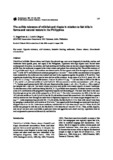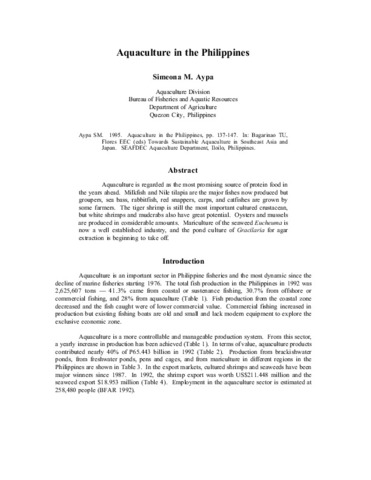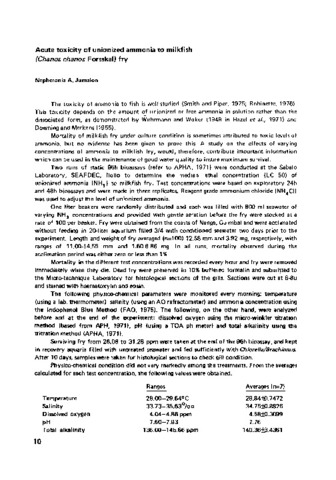The sulfide tolerance of milkfish and tilapia in relation to fish kills in farms and natural waters in the Philippines
- Global styles
- MLA
- Vancouver
- Elsevier - Harvard
- APA
- Help

閲覧/開く
日付
1998Page views
3,992ASFA keyword
AGROVOC keyword
Taxonomic term
Metadata
アイテムの詳細レコードを表示するCited times in Scopus
- Citations
- CrossRef - Citation Indexes: 45
- Scopus - Citation Indexes: 47
- Captures
- Mendeley - Readers: 31
Share
抄録
Fish kills of milkfish Chanos chanos and tilapia Oreochromis spp. now occur frequently in brackish, marine, and freshwater farms (ponds, pens, and cages) in the Philippines. Aquafarms with high organic load, limited water exchange and circulation, no aeration, and high stocking and feeding rates can become oxygen-depleted and allow sulfide from the sediments to appear in the water column and poison free-swimming fish. The sulfide tolerance of 2-5 g milkfish and 5-8 g O. mossambicus was determined in 25-liter aquaria with flow-through sea water (100 ml min-1) at 26-30 °C and sulfide stock solutions pumped in at 1ml min-1. Total sulfide concentrations in the aquaria were measured by the methylene blue method and used in the regression against the probits of % survival. Four experiments showed that the two species have similar sulfide tolerance. In sea water of pH 8-8.5, about 163 ± 68 μM or 5.2 ± 2.2 mg l-1 total sulfide (mean ± 2 se) or 10 μM or 313 μg l-1 H2S was lethal to 50% of the fish in 4-8 h, and 61 ± 3 μM total sulfide or 4 μM H2S in 24-96 h (to convert all sulfide concentrations: 1 μM = 32 μg l-1). Earthen pond bottoms had 0-382 μM total dissolved sulfide (mean ± sd - 54 ± 79 μM, n - 76); a tenth of the samples had >200 μM. The water column may have such sulfide levels under hypoxic or anoxic conditions. To simulate some of the conditions during fish kills, 5-12 g milkfish were exposed to an abrupt increase in sulfide, alone or in combination with progressive respiratory hypoxia and decreasing pH. The tests were done in the same flow-through set-up but with sulfide pumped in at 25 ml min-1. The lethal concentration for 50% of the fish was 197 μM total sulfide or 12 μM H2S at 2 h, but 28-53 μM sulfide allowed fish to survive 6-10 h. Milkfish in aquaria with no aeration nor flow-through sea water died of respiratory hypoxia in 5-8 h when oxygen dropped from 6 to 1 mg l-1. Under respiratory hypoxia with 30-115 μM sulfide, the fish died in 2.5-4 h. Tests with low pH were done by pumping a weak sulfuric acid solution at 25 ml min-1 into aquaria with flow-through sea water such that the pH dropped from 8 to 4 in 5 h. Under these conditions, milkfish died in 7-9 h when the pH was 3.5. When 30-93 μM sulfide was pumped in with the acid, the fish died in 2-6 h when the pH was still 4.5-6.3. Thus, sulfide, hypoxia, and low pH are each toxic to milkfish at particular levels and aggravate each other's toxicity. Aquafarms must be well oxygenated to prevent sulfide toxicity and fish kills.
Suggested Citation
Bagarinao, T., & Lantin-Olaguer, I. (1998). The sulfide tolerance of milkfish and tilapia in relation to fish kills in farms and natural waters in the Philippines. Hydrobiologia , 382(1-3), 137-150. https://doi.org/10.1023/A:1003420312764
Type
ArticleISSN
0018-8158Collections
- Journal Articles [1249]
Related items
Showing items related by title, author, creator and subject.
-
Aquaculture in the Philippines
Aypa, Simeona M. (Aquaculture Department, Southeast Asian Fisheries Development Center, 1995)Aquaculture is regarded as the most promising source of protein food in the years ahead. Milkfish and Nile tilapia are the major fishes now produced but groupers, sea bass, rabbitfish, red snappers, carps, and catfishes ... -
Enrichment of live food with essential fatty acids and vitamin C: effects on milkfish (Chanos chanos) larval performance
Gapasin, R. S. J.; Bombeo, R.; Lavens, P.; Sorgeloos, P.; Nelis, H. (Elsevier, 1998)The effects of essential fatty acids (EFA) and vitamin C-enriched live food on growth, survival, resistance to salinity stress and incidence of deformity in milkfish larvae reared in tanks were investigated. Larvae were ... -
Acute toxicity of unionized ammonia to milkfish (Chanos chanos Forsskal) fry
Jumalon, Nepheronia A. (Aquaculture Department, Southeast Asian Fisheries Development Center, 1979)







